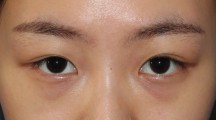Abstract
Total dry eye is encountered less frequently, but it may lead to blindness. Transposition of parotid duct to the conjunctival cul-de-sac is a method of treatment for advanced cases of xerophthalmia to prevent blindness. Tears and parotid secretions have similar composition; therefore saliva provides an excellent replacement for tears. Limitation of this procedure is that the length of the parotid duct may not be adequate to reach the conjunctival cul-de-sac. This study was conducted in 30 fresh cadavers to assess the length of parotid duct and technical feasibility of parotid duct transposition for the treatment of dry eye. The parotid duct was dissected and resting length of parotid duct was measured on both sides without stretching. The distance between ear lobule to lateral canthus was also measured on both sides in each cadaver. The length of parotid duct ranges from 4.5 to 7 cm with average length was 5.8 cm. The majority of the cadavers had parotid duct length of 6 cm. Length of the right and left parotid duct was found to be equal in all cadavers. Parotid duct reached comfortably in 24 cadavers (80%) while it was short in 6 cadavers (20%) by 1–1.50 cm in length. Parotid duct can be transposed easily to the lower conjunctival cul-de-sac in majority of the cases. If the parotid duct is falling short than a cuff of the buccal mucosa can be taken in order to gain length.




Similar content being viewed by others
References
Jones LT (1966) The lacrimal secretory system and its treatment. Am J Ophthalmol 62:47–60
Shanon E, Lazar M, Redianu C (1973) Surgical treatment of xerophthalmia. Laryngoscope 83:1999–2002
Khurana AK, Khurana AK, Khurana B (2011) Xerophthalmia-systemic ophthalmology-comprehensive ophthalmology, vol 4. Publisher Jaypee Brothers Medical Publishers, New Delhi, p 433
Agrawal LP (1953) Tissue therapy in parenchymatous xerosis. Bt J Ophthalmol 37:102–105
Tardy ME, Skolnik EM, Mills JM (1966) Parotid duct transposition in xerophthalmia. Report of a case. Arch Otolaryngol Head Neck Surg 148:778–786
Yen HY, Lee C (1954) Transplantation of parotid duct for the treatment of xerophthalmia. Chin J Ophthalmol 6:474–477
Bennett JE, Bailey AL (1957) Surgical approach to total xerophthalmia: transplantation of the parotid duct to the inferior cul-de-sac. Arch Ophthalmol 58:367–372
Filatov VP, Chevaljev VE (1951) Surgical treatment of parenchymatous ophthalmoxerosis. J Ophthalmol (Odessa) 3:131–137
Ashley FL, Schwartz AN, Straatsma BR, Ford JC (1959) Transplantation of the parotid duct for xerophthalmia. Am Surg 25:815–818
Crawford B (1970) Parotid duct transplantation for ocular xerosis. Trans Aust Coll Ophthalmol 2:92–95
Rhodes M, Heinrich C, Featherstone H, Braus B, Manning S, Cripps PJ, Renwick P (2012) Parotid duct transposition in dogs: a retrospective review of 92 eyes from 1999 to 2009. Vet Ophthalmol 15:213–222
Kaplunovich PS (1958) Contrast radiography of Stensens duct connection with its transplantation to the conjunctival sac in xerophthalmia and a method of lengthening the duct too short. In: Abstracts of proceedings of the all Russian conference of the ophthalmologists and the twelve extramural session Helmholtz Institute of Eye Diseases, pp 128–129
Horsburgh A, Massoud TF (2013) The salivary ducts of Wharton and Stenson: analysis of normal variant sialographic morphometry and a historical review. Ann Anat 195:238–242
Stringer MD, Mirjalili SA, Meredith SJ, Muirhead JC (2012) Redefining the surface anatomy of the parotid duct: an in vivo ultrasound study. Plast Reconstr Surg 130:1032–1037
Mark M, Scott LK, Weinstein G (1995) How I do it; head and neck and plastic surgery; a targeted problem and its solution; “Parotid Duct Transposition for Xerophthalmia and Facial Paralysis”. Laryngoscope 105:80–82
Nicholas JP, Brown FA (1962) Management of epiphora following parotid duct transposition for xerophthalmia. Arch Ophthalmol 68:529–531
Bennett JE, Armstrong JR, Jones RE, Schiller F (1959) Conjunctivoantro-rhinostomy; a gravity drainage operation utilizing the maxillary sinus, with report of two cases. AMA Arch Ophthalmol 62:248–254
Jonws LT (1954) Epiphora: its causes and new surgical procedures for its cure; a preliminary report. Am J Ophthalmol 38:824–831
Geerling G, Sieg P (2008) Surgery for the dry eye. In: Geerling G, Brewitt H (eds): Transplantation of the major salivary glands. Karger, Basel. Dev Ophthalmol 41:255–268
Author information
Authors and Affiliations
Corresponding author
Ethics declarations
Conflict of interest
All author declares that they have no conflict of interest.
Additional information
Publisher's Note
Springer Nature remains neutral with regard to jurisdictional claims in published maps and institutional affiliations.
Rights and permissions
About this article
Cite this article
Agarwal, P., Dhakad, V. & Sharma, D. Feasibility of Parotid Duct Transposition for the Treatment of Dry Eye: A Cadaveric Study. Indian J Otolaryngol Head Neck Surg 71, 29–32 (2019). https://doi.org/10.1007/s12070-018-1559-1
Received:
Accepted:
Published:
Issue Date:
DOI: https://doi.org/10.1007/s12070-018-1559-1




